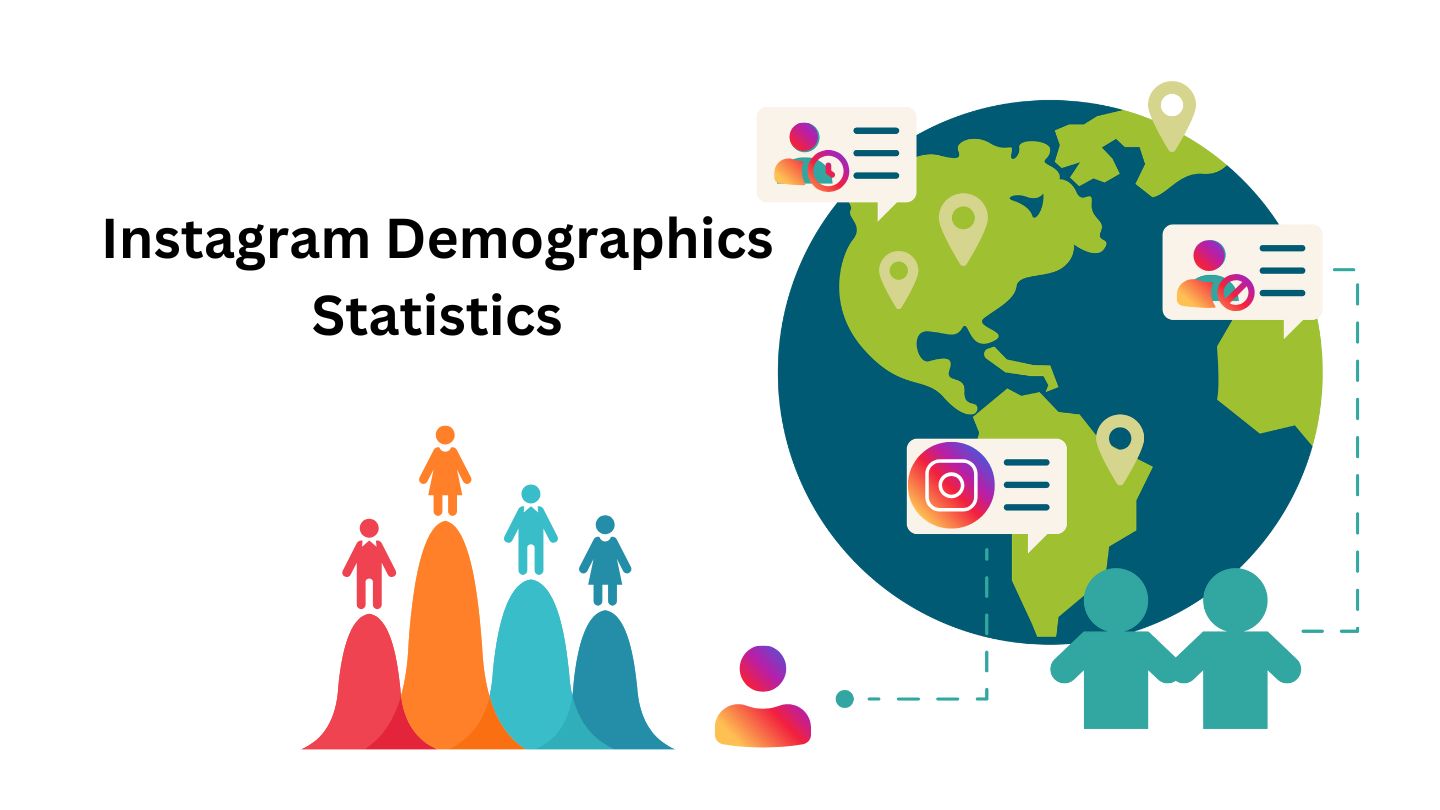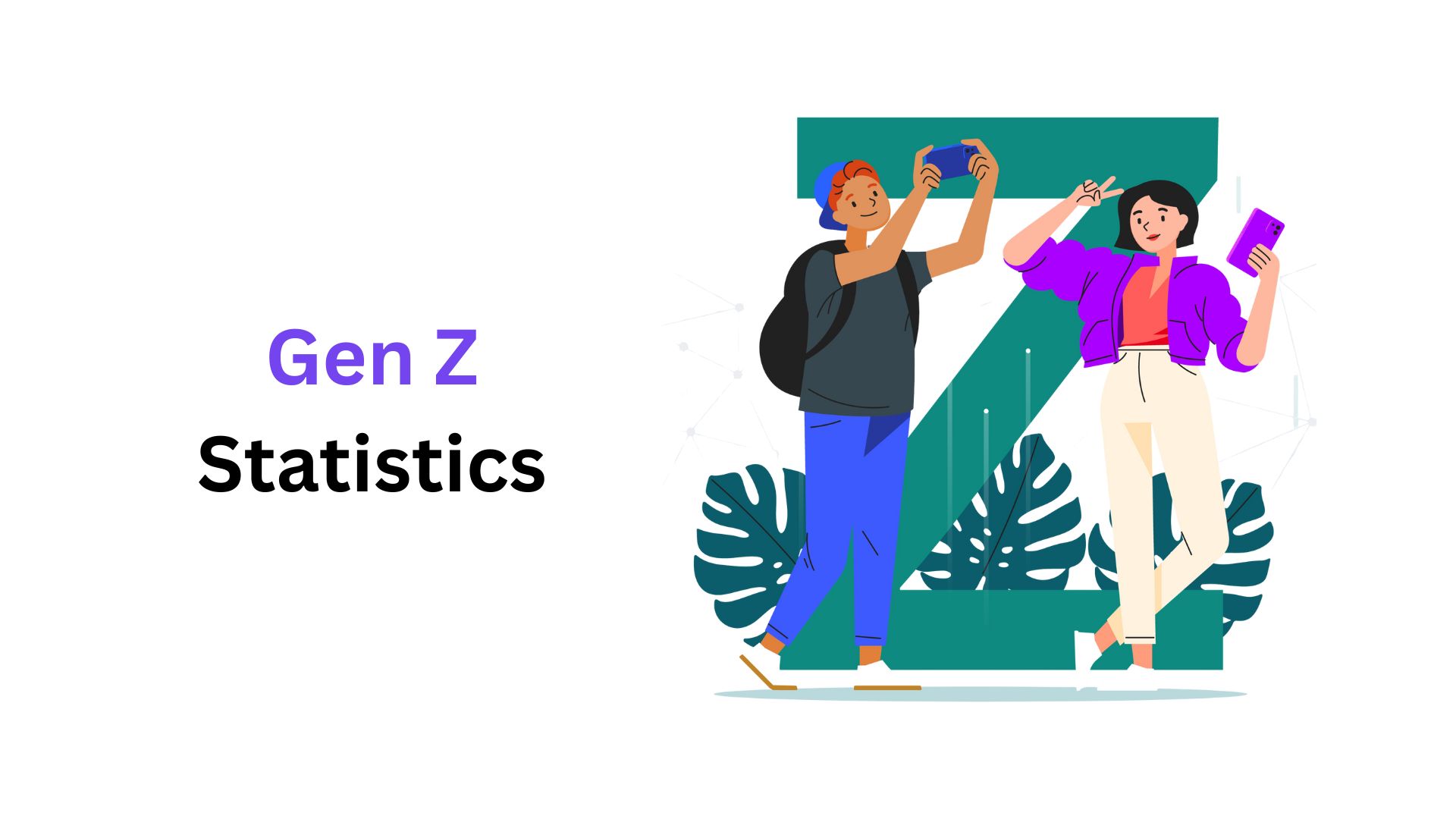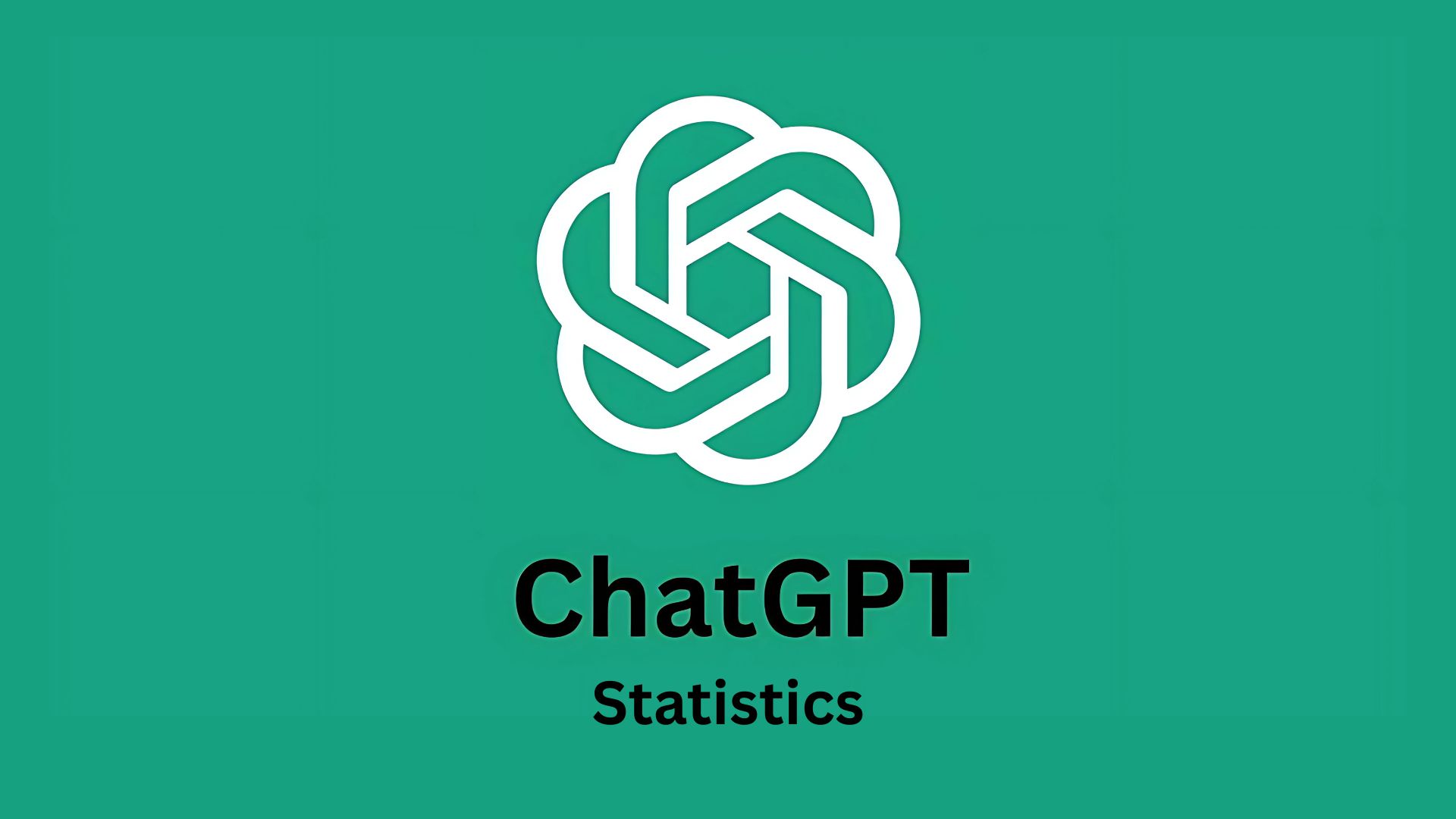Domestic Violence Statistics – Insights, Key Facts And Figures (2025)
Updated · Nov 04, 2025

Table of Contents
- Introduction
- Editor’s Choice
- Coercive control or controlling behavior Statistics
- Sexual Violence Statistics
- Image-Based Abuse Statistics
- Verbal Abuse Statistics
- Social Abuse for Women Statistics
- Elder Abuse Statistics
- Homelessness Statistics
- Pregnancy and Domestic Violence
- Stalking Statistics
- Domestic Violence in India 2024
- Economic Costs Against Women and Girls
- Technology-Facilitated Violence Against Women and Girls
- Female Genital Mutilation Statistics
- Conclusion
Introduction
Domestic Violence Statistics: Every minute, someone faces abuse at home—a place that’s supposed to feel safe. Domestic violence is a serious issue that affects millions of people, no matter their age, gender, income, or background. Examining the latest numbers helps us understand the magnitude of this problem and why it requires more attention.
In this article, we’ll share key Domestic Violence Statistics, illustrate its impact on people and communities, and highlight important trends across different age groups, genders, and locations. Whether you’re a student, parent, community leader, or just someone who cares, this information can help you see why raising awareness is the first step toward change.
Editor’s Choice
- A median of 24 people every minute are victims of domestic violence, rape and stalking by their partner in the U.N and more than 12 million females and males over the past year.
- Almost 3 out of 10 females (10%) In the United States have witnessed physical violence, stalking and rape by a partner and stated it has a related impact on their functioning.
- Domestic Violence Statistics stated that only 15% of the females (14.8%) and 4% of the men in the United States have been the victims of severe domestic violence by a partner in their lifetime.
- Almost 32% of victims of coercive control were aged 30 to 39 years.
- Almost 76% of victims of coercive control were the current spouse or ex-spouse of the alleged offender.
- Intimate partner domestic violence affects more than 12 million people every year.
- Almost 35.6% of women and 28.5% in the United States have witnessed physical abuse, stalking and rape by intimate partners in their life.
- Nearly 50% of all females and males in the United States have witnessed mental abuse by their partners in their lifetime.
- Females between 18 and 24 years and 25 and 34 years witness a high rate of intimate partner violence.
- Countries like Sudan, Indonesia, the U.S., Finland, and Poland have taken steps to strengthen their anti-FGM laws.
- In Mumbai, India, reports of crimes against women jumped by 12.8%, and child sexual abuse cases increased by 21%.
- From 1994 to 2010, almost 80% of victims of intimate partner violence were women.
- The maximum women victims of intimate partner abuse were victimized by the same person at rates of 77% for women between 18 and 24 years, 76% for women between 25 and 34 years, and 81% for women between 35 and 49 years.
- About 66% of young women reported facing verbal abuse, bullying, or sexual harassment at their jobs.
- In Australia, about 78% of women say they’ve been harassed in public places, like on public transport or sidewalks.
Coercive control or controlling behavior Statistics

- In 2024 and 2025, almost 157 new cases of coercive control have been observed.
- The following table shows the nature of controlling behavior:
| Controlling behavior identified | July 24 | August 24 | September 24 | October 24 | November 24 | December 24 | Total behaviors Jul-Dec 2024 | % of coercive control incidents |
| Harassment, monitoring or tracking | 12 | 21 | 10 | 8 | 26 | 12 | 89 |
57% |
|
Threats or intimidation |
12 | 15 | 6 | 11 | 20 | 11 | 75 | 48% |
| Shaming, degrading, or humiliating | 12 | 16 | 7 | 10 | 18 | 8 | 71 |
45% |
|
Financial abuse |
10 | 14 | 10 | 11 | 13 | 12 | 70 | 45% |
| Social isolation or cultural abuse | 8 | 15 | 10 | 9 | 14 | 10 | 66 |
42% |
|
Physical violence |
7 | 11 | 5 | 4 | 11 | 5 | 43 | 27% |
| Deprive liberty or otherwise control | 6 | 8 | 3 | 6 | 8 | 6 | 37 |
24% |
|
Damage or destruction of property |
3 | 7 | 0 | 4 | 8 | 8 | 30 | 19% |
| Other Coercive behaviour | 4 | 6 | 5 | 2 | 1 | 5 | 23 |
15% |
|
Sexual Violence |
1 | 4 | 3 | 3 | 3 | 3 | 17 | 11% |
| Animal abuse | 1 | 2 | 1 | 1 | 4 | 0 | 9 |
6% |
|
Harm to the child |
1 | 1 | 1 | 1 | 1 | 0 | 5 | 3% |
| Total coercive control incidents | 22 | 35 | 20 | 24 | 34 | 22 | 157 |
– |
- 39% or 61 events of coercive control were the only recorded offence.
- Almost 61% or 96 events of multiple offences were recorded in the event; the most common co-occurring offences were:
#1. DV assault – recorded in 49% of events
#2. Intimidation/Stalking – recorded in 41% of events.
#3. Sexual assault – recorded in 11% of events:

- 95% of the victims of coercive control were females.

- 94% of the coercive control incidents involved a female victim and a misalleged offender
- Domestic Violence Statistics stated that just 17% of victims of coercive control were Aboriginal.
- 133% of victims of coercive control were non-Aboriginal.
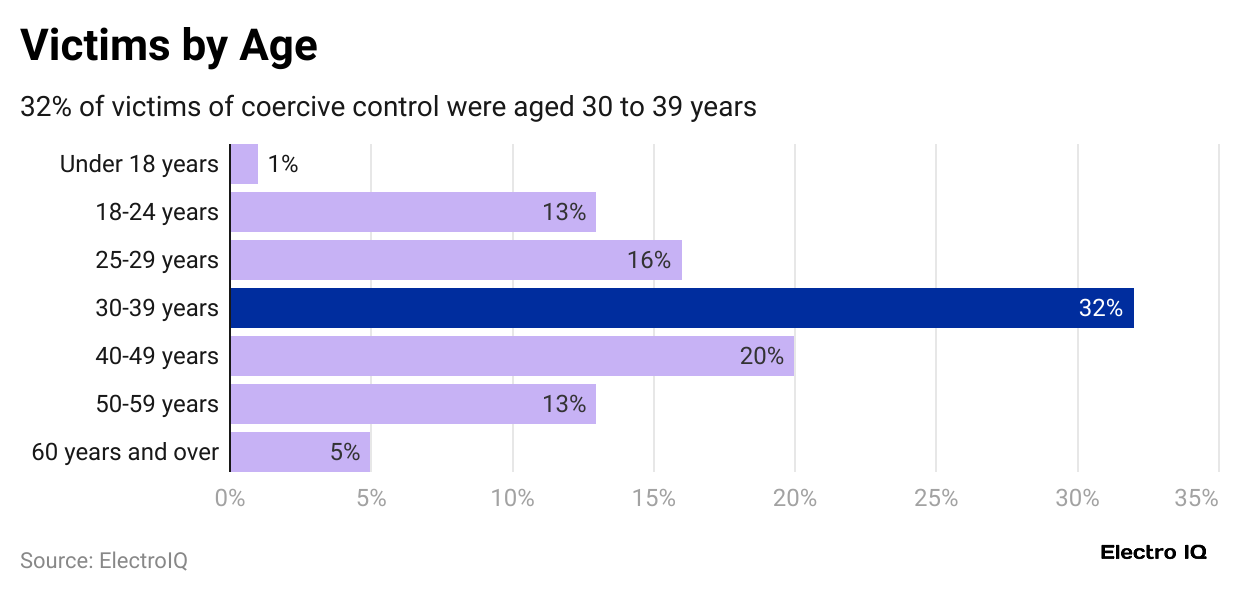
- Almost 32% of victims of coercive control were aged 30 to 39 years.

- Almost 76% of victims of coercive control were the current spouse or ex-spouse of the alleged offender.
Sexual Violence Statistics
- Domestic Violence Statistics stated that about 91% of people who go through rape or sexual assault are women, while only 9% are men.
- Nearly 99% of those who commit these crimes are men. This data from the U.S. Department of Justice does not include people who don’t identify as male or female.
- Around the world, 1 in 3 women has been hit, pressured into sex, or mistreated in other ways during her life.
- Only about 2% of rapists ever get convicted and sent to jail.
- Between 80% and 85% of rapes are committed by someone the victim knows.
- In one study, 42% of gay, lesbian, and bisexual college students said they had been forced to have sex. This was nearly double the rate of 21% among straight students in the same study.
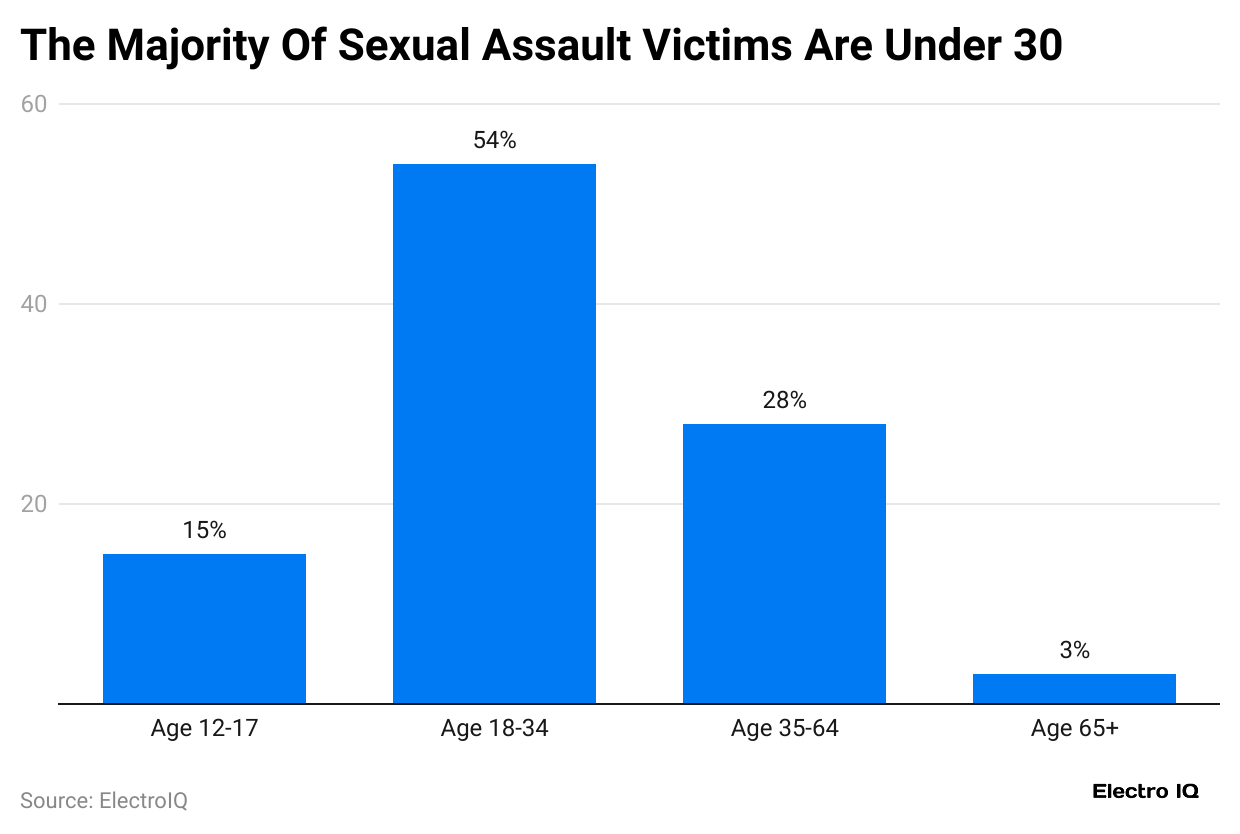
- Even though 80% of reported rape cases involve white women, women from minority groups face a higher risk. Here are the reported rape rates by race:
#1. White: 17.7%
#2. Black: 18.8%
#3. Asian or Pacific Islander: 6.8%
#4. American Indian/Alaska Native: 34.1%
#5. Mixed Race: 24.4%
- The real numbers for women of color are likely higher since many face more challenges when trying to report abuse.
- Native American women are the only group more likely to be attacked by someone of a different race.
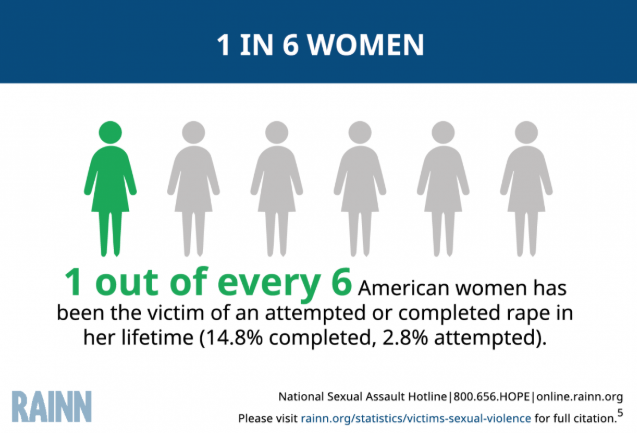
- By age 18, about 1 in 4 girls and 1 in 7 boys will have experienced some sexual abuse.
- Women who are attacked by a current or former male partner are more likely to have physical injuries compared to women assaulted by someone less familiar.
- Women who report rape in a relationship say they are sexually assaulted about 20 times on average during that relationship.
- Among adults with developmental disabilities, up to 83% of women and 32% of men have been sexually abused.
- Out of 22 substances found in cases of drug-related sexual assault, alcohol is the most common one used.
- People with mental health conditions are twice as likely to face violent crimes—including sexual assault—compared to the general population.
- Women dealing with homelessness and mental illness have a 97% chance of being violently attacked, including sexual abuse, at some point in their lives.
Image-Based Abuse Statistics
- Among adults 18 and older, about 15% of women have gone through image-based abuse, which is more than twice the rate for men, at just 7%.
- The biggest difference between women and men shows up in the 18–24 age group—24% of young women in this group have been targeted, compared to 16% of young men.
- Among teenage girls aged 15 to 17, about 15% have experienced image-based abuse too.
- As people get older, the number of those affected by this type of abuse drops.
- Around 20% of women aged 18–45 have dealt with image-based abuse, while only 4% of women aged 46 and up have been affected.
- For men, the numbers are similar—16% of men aged 18–45 have faced it, compared to 4% of men over 46.
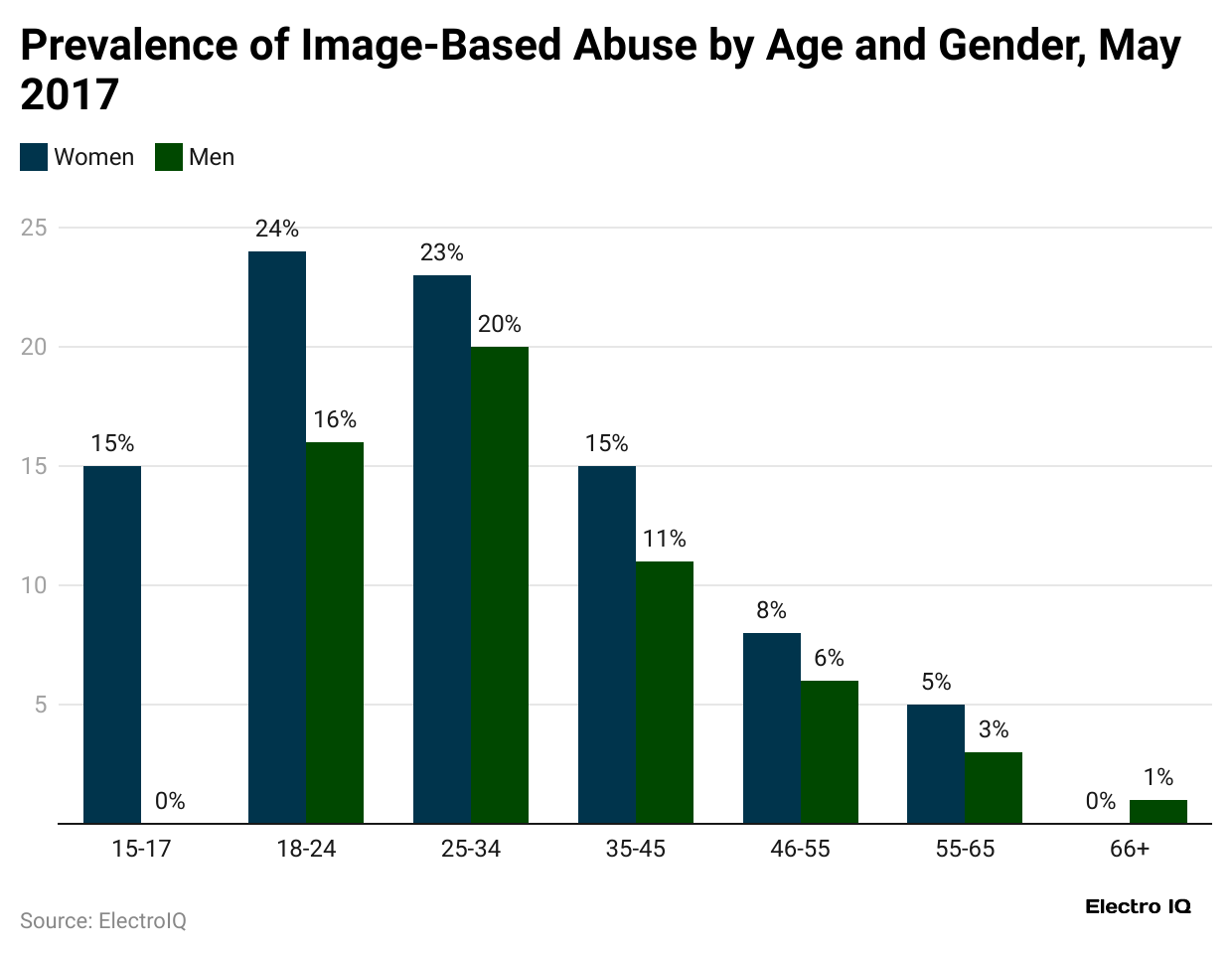
- People who felt pressured in the past year to take sexual photos or videos of themselves were more likely to face image-based abuse; 47% of them reported being harmed this way.
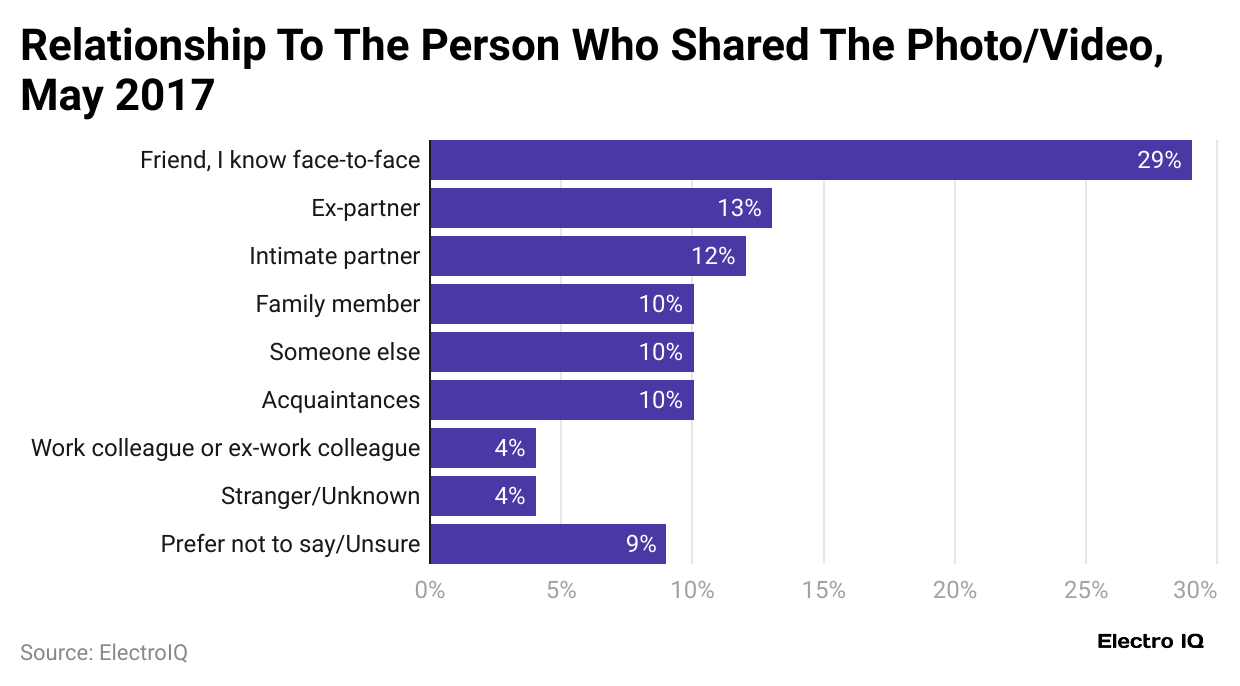
| Reasons | % of those who experienced image-based abuse |
|
Friend, I know face-to-face |
29% |
| Ex-partner |
13% |
|
Intimate partner |
12% |
| Family member |
10% |
|
Someone else |
10% |
| Acquaintances |
10% |
|
Work colleague or ex-work colleague |
4% |
| Stranger/Unknown |
4% |
|
Prefer not to say/Unsure |
9% |
- The risk was also high for those who chose to take sexual selfies, with 33% saying they were abused.
- Among adults who use the internet and have gone through image-based abuse, 63% said someone they trusted, like a partner, friend, or relative, shared their private images without asking.
- Even people who didn’t take any nude or sexual images in the past 12 months weren’t completely safe. Around 9% of them still became victims of image-based abuse.
Verbal Abuse Statistics
#1. Public Transportation
- In Dhaka, Bangladesh, verbal abuse on buses is extremely common for working women. In 2024:
- About 98% of women said they faced some verbal harassment while using public buses.
- Domestic Violence Statistics stated that almost 62% said they were regularly catcalled.
- About 92% reported hearing rude comments from others during their commute.
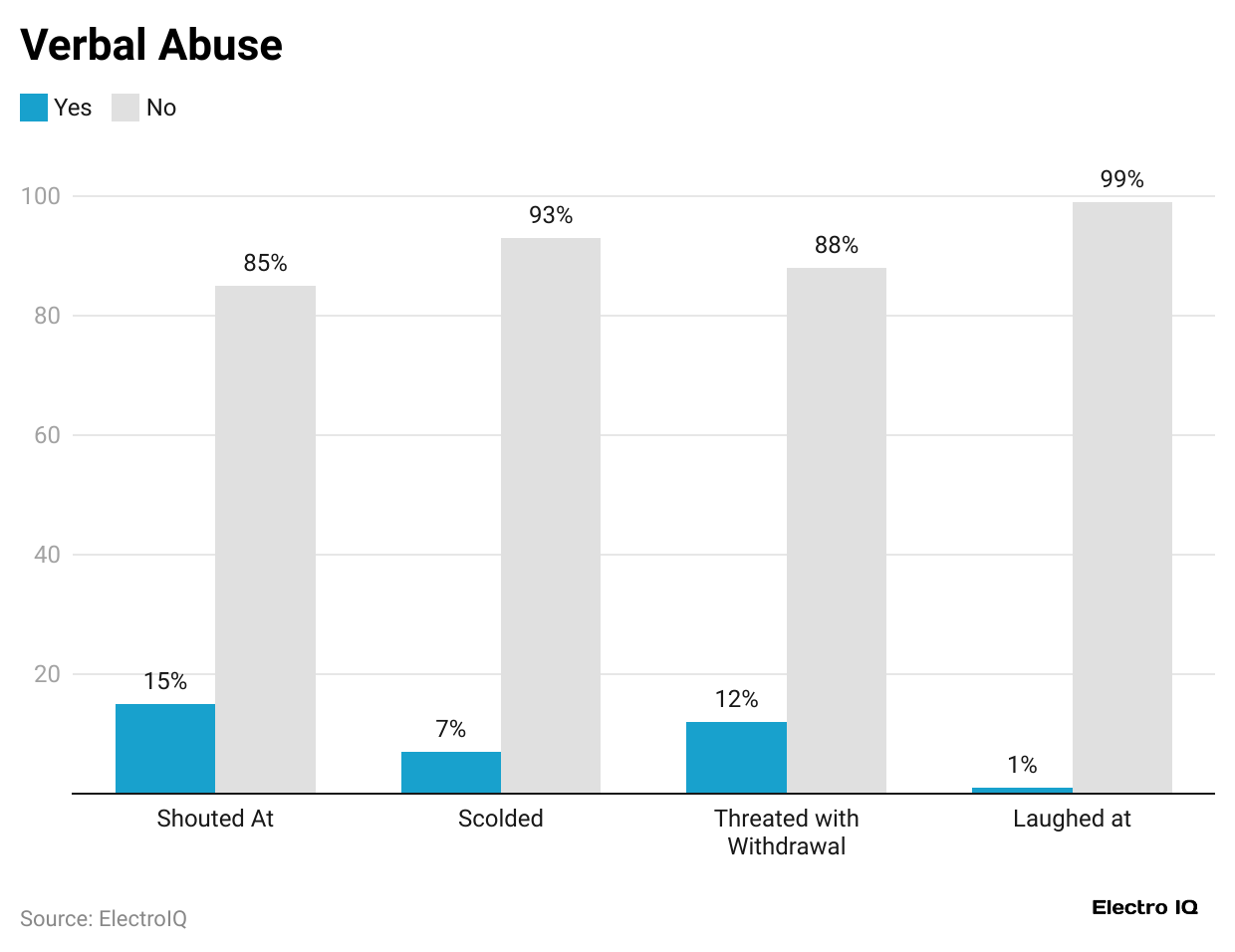
#2. At the Workplace
- A global report from 2024 found that:
- 19% of women experienced verbal harassment at work.
- 31% reported receiving repeated, unwanted comments or advances.
- 17% felt that men tried to talk over or ignore them in meetings.
- Domestic Violence Statistics stated that 33% said they were uncomfortable because of sexually inappropriate language or jokes in the office.
#3. Young Women at Work
- About 66% of young women reported facing verbal abuse, bullying, or sexual harassment at their jobs.
#4. Online Abuse
- Twenty-two per cent of adults reported being seriously harassed online.
- A UN report found that 67% of women experienced online hate, name-calling, or false claims—forms of verbal violence.
Social Abuse for Women Statistics
- In England and Wales, about 9.5% of women (roughly 2.3 million) said they were abused by a partner or family member in the past year, compared to 6.5% of men. Since turning 16, about 30.3% of women have faced this kind of violence.
- In Scotland, domestic abuse reports went up by 11% in early 2024. More than 80% of the people accused were men.
- In Mumbai, India, reports of crimes against women jumped by 12.8%, and child sexual abuse cases increased by 21%.
- Across India, the top reported crime against women was cruelty by husbands or in-laws, making up 31.4% of all such cases.
- In countries under the OECD, about 22% of women said they had been hurt physically or sexually by a partner during their lives. Four per cent said it happened within the past 12 months.
- A global study found that 82% of women in politics said they were emotionally abused, like being insulted or threatened. Also, 44% got death or rape threats online.
- Around the world, 60% of women who use the internet said they had faced online attacks, like harassment, sharing private photos without permission, or threats.
- In the UK, 73% of women journalists faced online harassment. Even worse, 1 in 5 (or 20%) said they were also harassed in person afterwards.
- Online abuse makes many women feel unsafe. Only 23% of women in the UK feel okay sharing their political opinions online, compared to 40% of men.
- In Australia, about 78% of women say they’ve been harassed in public places, like on public transport or sidewalks.
- Nearly 60% of women online said they’ve been targets of tech-based gender violence—this includes cyberstalking, threats, or sharing personal images without their OK.
Elder Abuse Statistics
- Almost 10% of the people in the U.S. who are 60 years and older living at home will witness abuse, negligence, and even exploitation.
- In nursing homes or other community care centres, almost 16% of the elders stated being abused.
- Domestic Violence Statistics stated that almost 1% of the citizens were involved in the abuse, exploitation, and negligence of the nursing home residents.
- In 2023, United States homes got almost 94.499 health citations.
- Around 7,654 of the citizens in the U.S. were issued because of neglect, exploitation, and abuse.
| Types of abuse in complaints | % of all complaints. |
| Sexual abuse |
8% |
|
Financial exploitation |
14% |
| Psychological abuse |
16% |
|
Gross neglect |
24% |
| Physical abuse |
38% |
Homelessness Statistics
- In January 2023, women made up 36% of homeless adults in Ireland. That’s much higher than the European average, which usually ranges between 20% and 33%.
- The actual number of homeless women may be even higher. Experts say this issue is often undercounted because many women stay with friends, family, or in unsafe places, so they don’t always appear in official data.
- Each month, an average of 180 women and 275 children seek emergency housing assistance.
- In 2021, services had to turn away over 3,000 requests for shelter because there weren’t enough safe spaces available.
Pregnancy and Domestic Violence
- Almost 320,000 pregnant women are abused by their partners every year.
- Around 6% of people experience emotional, physical, and sexual violence during pregnancy by an intimate partner.
- Almost 45.3% of murders of pregnant women (or within a year of pregnancy) were linked to intimate partner violence.
- Homicide is the leading cause of death for pregnant women or those who have recently given birth.
- Almost two-thirds of people who have experienced intimate partner violence during pregnancy also experienced it before pregnancy.
Stalking Statistics
- Around 13.5 million people in the U.S. are stalked every year. About 33% of women and 16% of men go through stalking at some point in their lives, according to overall domestic violence rates.
- Anyone can be a stalker or a victim, but most victims (78%) are women, and most stalkers (87%) are men.
- In many cases, the stalker is someone the victim already knows.
- 42% are stalked by someone they’re familiar with, and a current or past partner targets 40%.
- Domestic Violence Statistics stated that only 19% are stalked by someone they don’t know.
- Nearly 72% of victims are threatened with physical violence. Slightly more men (80%) than women (69%) report being threatened.
- Technology is now a common tool in stalking. Victims are 2x more likely to be stalked using tech (like texts, social media, or GPS) than not.
- Almost 50% of victims get unwanted contact at least once a week, and about 66% say the stalker reaches out weekly or even daily.
- For most, stalking lasts between 1 to 2 years, but 11% are stalked for more than 5 years. Approximately one in three stalkers has done it to someone else before.
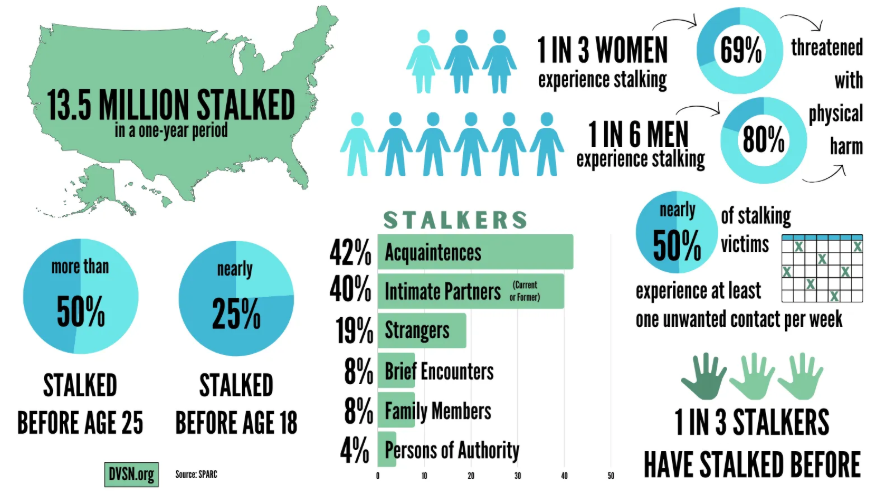
- Young people also face stalking more often. Over 50% of victims say they were stalked before age 25, and nearly 25% say it started before they turned 18.
- For teenagers and college students, the stalker is most often a former boyfriend or girlfriend (33%), followed by someone they know personally, like a fellow student (23–31%).
The risk of being stalked is higher for:
- Women
- Students of color
- LGBTQIA+ individuals
- People with disabilities
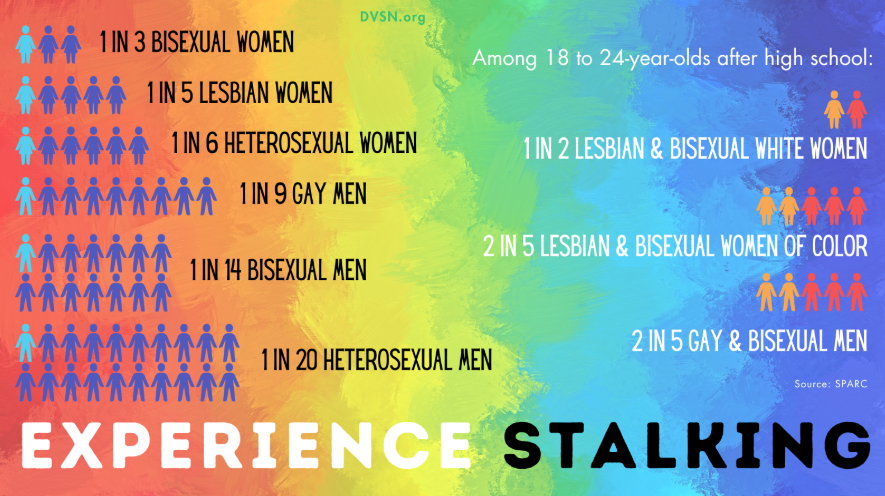
- Around 75% of stalking victims say they got phone calls they didn’t want, while 57% received unwanted texts, emails, or messages on social media.
- The same number, 57%, reported that their stalker showed up or came near them in places where they weren’t welcome.
- About 52% were followed or watched by the person stalking them.
- A smaller portion, 26%, reported receiving gifts, cards, or letters they hadn’t asked for.
- Approximately one in five stalkers used a weapon to scare or harm their victim.
- Of those, 42% used a knife or sharp object, 38% used a blunt weapon, and 23% used a gun.
Domestic Violence in India 2024
- In 2024, India recorded 45,256 cases of crimes against women—an increase of 4% from the year before.
- Out of all these, around 31.4% were related to cruelty by husbands or their relatives.
- In 2024, the National Commission for Women (NCW) got about 25,743 total complaints, and about 24% of them were specifically about domestic violence—that’s roughly 6,237 reports.
- Uttar Pradesh reported the highest number of complaints, accounting for 54% of all cases received by NCW in 2024.
- Other top states include Delhi (9%), Maharashtra (5.1%), Bihar (4.8%), Madhya Pradesh (4.2%), and Haryana (4.1%).
- According to health survey data, about 80% of women who suffer domestic violence never tell anyone.
- Only 6.3% of survivors go to the police.
- Between September 2024 and March 2025, a women’s helpline received nearly 172,000 calls, but only a small number of them turned into official cases. That includes 667 cases of sexual abuse and 550 cases of emotional abuse.
Based on NFHS‑5 (2019–21), women aged 15–49 across India experienced:
#1. 31.2% – some form of domestic abuse
#2. 28.5% – physical abuse
#3. 13.1% – emotional abuse
#4. 5.7% – sexual abuse
Some of the worst-hit areas include:
#1. Karnataka – 47.3%
#2. Bihar – 42%
#3. Manipur – 40.4%
#4. Ladakh – 40.2%
#5. Telangana – 40.2%
In contrast, safer states showed much lower numbers:
#1. Lakshadweep – 0.8%
#2. Goa – 9.8%
- India has laws like Section 498A of the Indian Penal Code and the Domestic Violence Act of 2005, but many victims still don’t get justice.
- Cultural beliefs also play a role—about 45% of women believe domestic abuse is acceptable in some cases.
- A shocking 86% of women don’t even talk to friends or family about what they’re going through.
Economic Costs Against Women and Girls
- In Vietnam, the money women spend directly, and the income they lose because of abuse, equals about 1.41% of the country’s total GDP. Women who go through violence make 35% less than women who haven’t faced abuse, showing how violence affects both their income and the nation’s economy.
- In Egypt, domestic abuse leads to the loss of around 500,000 workdays each year. The health system spends more than $14 million annually to care for 600,000 survivors, which accounts for only 25% of the total affected population.
- In Morocco, the yearly cost of physical and/or sexual violence against women is about 2.85 billion dirhams, or around $308 million.
- In the European Union, gender-based violence costs about €366 billion every year. Of that, violence against women makes up 79%, which is around €289 billion.
Technology-Facilitated Violence Against Women and Girls
- Around 31% of adult women worldwide have been victims of online sexual harassment, such as being pressured for explicit images or threatened with them.
- Reports show that between 16% and 58% of women globally have faced some form of digital abuse, like online threats, harassment, or the sharing of private content without permission.
- About 58% of women said they’ve been harassed on social media, according to the Institute of Development Studies.
Among women who are targeted online:
#1. 67% said people spread lies or false accusations about them.
#2. 66% experienced cyberbullying or repeated unwanted messages.
#3. 65% were attacked with offensive or hateful speech.
#4. 63% had someone pretend to be them online.
#5. 63% were stalked digitally or had their accounts hacked.
#6. 57% had private images shared without consent.
#7. 55% were doxxed (personal info shared publicly).
#8. 52% were directly threatened with violence.
#9. 43% got unsolicited sexual photos or videos.
- In the European Union, about 10% of women have been cyber-harassed since they were 15 years old.
- In Bangladesh, about 78% of women experienced some online abuse, often through Facebook, WhatsApp, or Imo.
- In Europe and Central Asia, more than 53% of women reported being targeted online at some point.
- In the Asia-Pacific region, 88% of teenage girls and marginalized women faced digital harassment. However, only 25% reported it to the platforms, and 14% informed the authorities.
- Young women between 18 and 29 are more likely to be stalked or threatened online.
- Women from racial or ethnic minorities, LGBTQIA+ groups, women with disabilities, and those working as journalists, activists, or politicians are more often targeted.
- About 73% of female journalists said they’ve been abused online.
- 85% of women have seen others being harassed online.
- In the EU, only 10% of women who face cyber harassment report it.
- Up to 83% of women changed how they used the internet after being harassed—many censored themselves or avoided certain platforms.
Female Genital Mutilation Statistics
- More than 230 million girls and women around the world have gone through female genital mutilation (FGM). That’s about 30 million more than in 2016.
- Around 4.4 million girls are at risk of FGM each year. That’s about 12,000 girls every day.
- If current trends continue, 27 million more girls could face FGM by 2030.
- The chance of a girl being cut has gone down by about 33% over the last 30 years.
- However, this decline is not fast enough. To meet the U.N. goal of ending FGM by 2030, the world must speed up progress by 27 times.
- Out of 31 countries with data, only seven are on track to stop FGM by 2030.
FGM is found mostly in:
#1. Africa – 144 million girls and women
#2. Asia – 80 million
#3. Middle East – 6 million
Countries with the highest % of women affected:
#1. Somalia – 99%
#2. Indonesia – 87%
#3. Guinea – 84%
#4. Mali – 81%
#5. Oman – 78%
Countries with the largest numbers:
#1. Indonesia – 121 million
#2. Egypt – 35 million
#3. Ethiopia – 29 million
#4. Sudan – 15 million
#5. Nigeria – 14 million
- 77% to 86% of global FGM cases are in Muslim communities.
- Only around 2% of non-Muslim women are affected.
- FGM is being done more often by health workers — about 1 in 4 cases. This trend, called medicalization, can make the problem worse by making it seem acceptable and safe, even though it causes serious harm.
- Globally, only 59 out of 94 countries that deal with FGM have laws that ban it.
- Countries like Sudan, Indonesia, the U.S., Finland, and Poland have taken steps to strengthen their anti-FGM laws.
- In Europe, lawmakers are pushing for stronger protections for girls at risk due to cross-border FGM cases.
- On February 6, 2025, the U.N. highlighted the urgent need to stop FGM during the International Day of Zero Tolerance.
The World Health Organization (WHO) released new rules to:
- Encourage doctors and nurses to refuse to perform FGM.
- Provide better medical and mental health care for survivors.
Conclusion
Domestic violence is a major issue that affects millions of people, especially women and children, in the U.S. and around the world. The Domestic violence statistics clearly show that abuse—whether it’s physical, emotional, sexual, or financial—happens far too often. Many survivors don’t report what happened, which means the real numbers may be even higher.
These facts demonstrate that we need to take further action: provide better support services, strengthen existing laws, and increase public awareness. Putting an end to domestic violence starts by believing in survivors, making sure they have safe places to go, and working together to create a safer future for all. We have shed enough light on Domestic Violence Statistics through this article.
Sources
FAQ.
The Sixteen Days of Action Against Domestic Violence is a worldwide campaign aimed at raising awareness and taking action to end domestic violence and gender-based abuse.
In 2025, the goal is to connect awareness and prevention by focusing on respect—respect for others in our lives and ourselves.
“Her Rights, Our Future, Right Now” is the official theme for International Women’s Day 2025, selected by U.N. Human Rights. It emphasizes the importance of standing up for women’s rights today to build a stronger and fairer future for all.

Saisuman is a skilled content writer with a passion for mobile technology, law, and science. She creates featured articles for websites and newsletters and conducts thorough research for medical professionals and researchers. Fluent in five languages, Saisuman's love for reading and languages sparked her writing career. She holds a Master's degree in Business Administration with a focus on Human Resources and has experience working in a Human Resources firm. Saisuman has also worked with a French international company. In her spare time, she enjoys traveling and singing classical songs. Now at Smartphone Thoughts, Saisuman specializes in reviewing smartphones and analyzing app statistics, making complex information easy to understand for readers.

